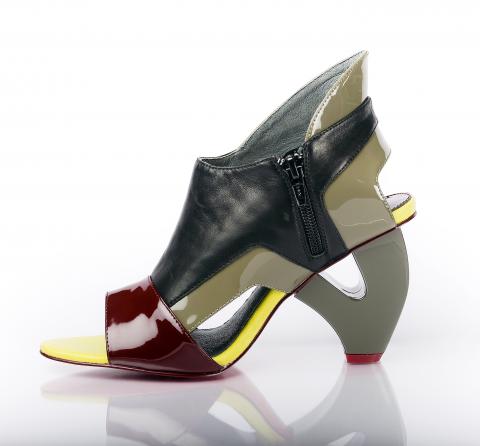With just two collections so far, Heavy Machine’s industrial-inspired shoes have caught the eyes of fashion insiders.
Sandals and pumps by the Taiwanese brand, which was launched in 2009, feature sculptural details like sharply angled resin heels and soaring platform soles. Feminine color combinations in jewel and sherbet tones offset the futuristic designs.
The brand has been written up in Ars Sutoria, a leading trade publication, US Glamour, Japan’s So-en, and appeared on influential fashion blogs Style Bubble (www.stylebubble.co.uk) and Kingdom of Style (www.kingdomofstyle.net).

Photo courtesy of Heavy Machine
Heavy Machine designers Yoyo Pan (潘國瑤) and Michelle Wu (吳怡慧) met four years ago. Both studied fashion design abroad, Pan at the Royal Melbourne Institute of Technology and Wu at the Fashion Institute of Technology in New York City. From the beginning of their friendship, the two talked about launching a line of shoes different from what was then available on the market.
“We liked shoes that are unusual and hard to find,” Wu says. “We wanted them to be completely unlike any other shoes.”
At the beginning, the two had to tone down some of their more exaggerated designs in order to make them manufacturable.

Photo courtesy of Heavy Machine
“The footwear makers said they couldn’t actually make it or else the shoes would turn out completely different from our sketches,” Wu says.
“At first we didn’t really understand the construction of shoes and just designed what we thought was cute,” Pan says. She enrolled at the Footwear and Recreation Technology Research Institute (台中鞋技中心) in Taichung, where she studied shoe engineering.
The duo look up to designers who are known for their conceptual creations, including Martin Margiela, Nicolas Ghesquiere and Helmut Lang, and their influence can be seen in Heavy Machine’s innovative designs.

Photo courtesy of Heavy Machine
But Pan and Wu’s brand has also earned kudos for its wearability. In one post, blogger Susanna Lau of Style Bubble pronounced a pair of shoes from Heavy Machine’s first collection “definitely comfortable” after a day spent walking around in them.
High-heeled sandals and pumps are balanced with a curved platform sole to stabilize the foot while walking. Heels are placed to support the weight of the body.
“I’m not very good at wearing high-heeled shoes. I find a lot of them uncomfortable and hard to walk in,” Wu says. “I want to make shoes that I can at least wear myself.”

Photo courtesy of Heavy Machine
From the start, Pan and Wu pursued an international market for Heavy Machine, attending trade shows including Designers and Agents (D&A) in New York City and Tranoi in Paris. Their shoes are currently sold in 10 countries, including Taiwan, Kuwait, Australia, the Netherlands, Japan and Hong Kong.
“We don’t have a target customer in mind,” Wu says. “Just as long as they are women — or men.”
“Yes, as long as they are people,” Pan adds.
For a list of stores, visit www.heavymachinedesign.com

April 14 to April 20 In March 1947, Sising Katadrepan urged the government to drop the “high mountain people” (高山族) designation for Indigenous Taiwanese and refer to them as “Taiwan people” (台灣族). He considered the term derogatory, arguing that it made them sound like animals. The Taiwan Provincial Government agreed to stop using the term, stating that Indigenous Taiwanese suffered all sorts of discrimination and oppression under the Japanese and were forced to live in the mountains as outsiders to society. Now, under the new regime, they would be seen as equals, thus they should be henceforth

Last week, the the National Immigration Agency (NIA) told the legislature that more than 10,000 naturalized Taiwanese citizens from the People’s Republic of China (PRC) risked having their citizenship revoked if they failed to provide proof that they had renounced their Chinese household registration within the next three months. Renunciation is required under the Act Governing Relations Between the People of the Taiwan Area and the Mainland Area (臺灣地區與大陸地區人民關係條例), as amended in 2004, though it was only a legal requirement after 2000. Prior to that, it had been only an administrative requirement since the Nationality Act (國籍法) was established in

With over 80 works on display, this is Louise Bourgeois’ first solo show in Taiwan. Visitors are invited to traverse her world of love and hate, vengeance and acceptance, trauma and reconciliation. Dominating the entrance, the nine-foot-tall Crouching Spider (2003) greets visitors. The creature looms behind the glass facade, symbolic protector and gatekeeper to the intimate journey ahead. Bourgeois, best known for her giant spider sculptures, is one of the most influential artist of the twentieth century. Blending vulnerability and defiance through themes of sexuality, trauma and identity, her work reshaped the landscape of contemporary art with fearless honesty. “People are influenced by

The remains of this Japanese-era trail designed to protect the camphor industry make for a scenic day-hike, a fascinating overnight hike or a challenging multi-day adventure Maolin District (茂林) in Kaohsiung is well known for beautiful roadside scenery, waterfalls, the annual butterfly migration and indigenous culture. A lesser known but worthwhile destination here lies along the very top of the valley: the Liugui Security Path (六龜警備道). This relic of the Japanese era once isolated the Maolin valley from the outside world but now serves to draw tourists in. The path originally ran for about 50km, but not all of this trail is still easily walkable. The nicest section for a simple day hike is the heavily trafficked southern section above Maolin and Wanshan (萬山) villages. Remains of